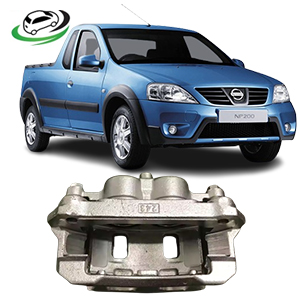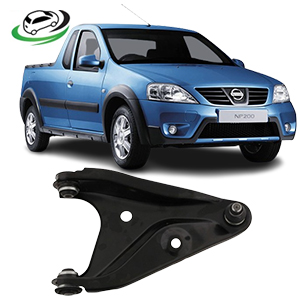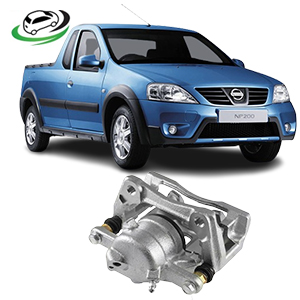Get Nissan Pick Up NP200 Front Brake Caliper LHS 41011-00Q0F
The front brake caliper on the left-hand side (LHS) of the Nissan NP200 is a critical component in the vehicle’s braking system. This detailed 1000-word guide explains the function, design, importance, common issues, and maintenance of the Nissan NP200’s LHS brake caliper. For any vehicle, especially utility-focused models like the NP200, maintaining optimal brake system performance is key for safety and driving reliability.
1. Overview of a Brake Caliper
The brake caliper is part of the disc braking system, a mechanism that slows the vehicle’s wheels through friction. This friction is generated when the caliper presses the brake pads against the brake rotor (or disc). For a vehicle like the Nissan NP200, which is commonly used for both daily commuting and light commercial activities, the caliper’s proper functioning is vital for safe and efficient operation.
The LHS brake caliper is identical in design to the RHS but is specifically engineered to fit the left side of the vehicle. The brake caliper ensures balanced stopping power across both sides, maintaining vehicle stability during braking.
2. Key Components of the LHS Brake Caliper
The LHS brake caliper on the Nissan NP200 comprises several essential parts, each with its own function:
- Caliper Body: This is the main structure that houses the pistons and brake pads. It’s typically made from durable materials such as cast iron or aluminum.
- Pistons: The pistons inside the caliper are responsible for pressing the brake pads against the rotor when hydraulic pressure is applied. In the Nissan NP200, the caliper uses a single-piston floating design.
- Brake Pads: These are friction materials that make contact with the rotor to slow down the vehicle. They are housed within the caliper and are crucial for braking performance.
- Guide Pins: These pins allow the caliper to slide smoothly and ensure even pressure is applied to the brake pads.
- Dust Boots and Seals: These protect the pistons and caliper components from dirt, debris, and moisture, ensuring smooth operation over time.
3. How the LHS Brake Caliper Works
The LHS brake caliper, like its counterpart on the right, operates using hydraulic pressure. Here’s a step-by-step breakdown of its operation:
- Brake Pedal Activation: When the driver presses the brake pedal, hydraulic pressure is generated in the master cylinder. This pressure is transferred through brake lines to the caliper.
- Piston Movement: Hydraulic fluid pushes the piston inside the caliper, forcing the brake pads to move toward the rotor.
- Friction Creation: The brake pads clamp onto the rotating rotor, creating friction. This friction converts the vehicle’s kinetic energy into heat energy, effectively slowing down the wheel’s rotation.
- Release: When the brake pedal is released, the hydraulic pressure is reduced, allowing the piston to retract slightly and the brake pads to disengage from the rotor. This ensures that the wheels can rotate freely without drag.
The sliding caliper design used in the Nissan NP200 allows the entire caliper body to move, pressing both brake pads onto the rotor. This ensures even braking force distribution, which is critical for maintaining stability, especially during sudden stops.
4. Benefits of a Functioning Front LHS Brake Caliper
The brake caliper on the left-hand side provides several key benefits to the Nissan NP200’s braking system:
- Improved Stopping Power: A well-maintained caliper ensures that sufficient force is applied to the brake pads, providing efficient and consistent stopping power.
- Even Brake Pad Wear: A sliding caliper ensures that both brake pads wear evenly, which extends their lifespan and ensures consistent braking performance.
- Safety: Properly functioning calipers on both sides of the vehicle ensure that the vehicle brakes in a straight line, reducing the risk of pulling to one side during emergency braking.
- Fuel Efficiency: A caliper that releases properly after braking prevents drag on the wheel, which can improve fuel efficiency by allowing the wheels to rotate freely.
5. Common Issues with the LHS Brake Caliper
Over time, brake calipers can develop problems due to wear and tear, environmental factors, and lack of maintenance. Some of the common issues that may arise with the LHS brake caliper include:
- Caliper Sticking: This occurs when the caliper fails to release the brake pads properly after the brake pedal is released. A sticking caliper can lead to constant friction between the pads and rotor, resulting in excessive heat, increased fuel consumption, and rapid pad wear.
- Brake Fluid Leaks: The seals within the caliper can wear out over time, leading to brake fluid leaks. A loss of brake fluid reduces hydraulic pressure, which compromises the caliper’s ability to press the brake pads effectively.
- Corrosion: Exposure to moisture, road salt, and debris can cause the caliper to corrode. Rust on the caliper’s sliding pins or piston can prevent smooth operation, leading to uneven braking.
- Uneven Brake Pad Wear: If the guide pins or caliper body do not move freely, the brake pads on one side of the rotor may wear faster than the other. This leads to uneven braking performance and can shorten the lifespan of the brake pads.
6. Maintenance Tips for the LHS Brake Caliper
Proper maintenance is essential to ensure the longevity and reliability of the brake calipers. Here are some key maintenance practices for the Nissan NP200 LHS brake caliper:
- Regular Inspections: Inspect the calipers during routine vehicle maintenance, checking for leaks, corrosion, or signs of wear. Any visible damage to the caliper or its components should be addressed promptly.
- Brake Fluid Maintenance: Check the brake fluid levels regularly and ensure that the fluid is free from contamination. Nissan recommends using DOT 4 brake fluid, and it should be replaced according to the vehicle’s service intervals (typically every 30,000 miles or two years).
- Lubrication of Guide Pins: The guide pins should be lubricated with high-temperature brake grease during brake pad replacement or routine servicing. This ensures that the caliper can slide smoothly and apply even pressure on both sides of the rotor.
- Brake Pad and Rotor Replacement: Replace worn brake pads and rotors before they are excessively damaged. Running the vehicle with worn pads can damage the caliper pistons and rotors, leading to more expensive repairs.
- Caliper Rebuild or Replacement: If the LHS caliper shows signs of sticking or leaking, it may need to be rebuilt or replaced. Caliper rebuild kits are available, which include new seals and pistons. Alternatively, a complete caliper replacement may be necessary.
7. How to Replace the LHS Brake Caliper
Replacing the LHS brake caliper on the Nissan NP200 is a relatively straightforward process but requires attention to detail to ensure proper installation. Below is a general guide on how to replace the caliper:
- Lift the Vehicle: Secure the vehicle on a jack and remove the front left wheel to access the brake assembly.
- Remove the Old Caliper: Unbolt the brake caliper from the mounting bracket and disconnect the brake hose. Be prepared for some brake fluid leakage when disconnecting the hose.
- Install the New Caliper: Mount the new caliper onto the bracket and reconnect the brake hose. Make sure to torque the bolts according to the manufacturer’s specifications.
- Bleed the Brakes: After installation, bleed the brake system to remove any air bubbles that may have entered the hydraulic lines.
- Test the Brakes: Once installed and bled, test the brakes by pressing the pedal and ensuring that it feels firm. Test-drive the vehicle to ensure proper braking performance.
8. Conclusion
The front left-hand side (LHS) brake caliper on the Nissan NP200 is a crucial component for ensuring safe and reliable braking performance. Understanding its function, common issues, and the importance of regular maintenance can help you keep your NP200’s braking system in top condition. Proper care of the LHS brake caliper, along with the rest of the braking system, ensures vehicle safety, reduces wear on brake components, and maintains optimal performance. Regular inspections and timely replacements are key to preventing expensive repairs and ensuring a smooth, safe driving experience.
Follow us on Facebook for more parts.



